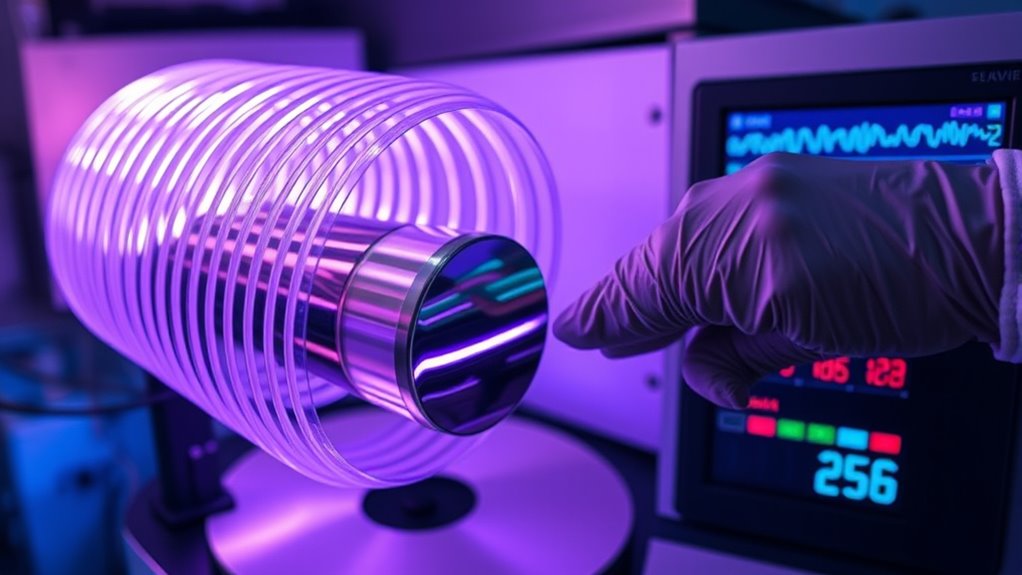NMR spectroscopy lets you see molecules by using magnetic properties of nuclei like hydrogen or carbon. When placed in a magnetic field, these nuclei align, and radiofrequency pulses then flip their spins, creating signals. These signals reveal details about the electronic environment, bonds, and connections within the molecule. Understanding chemical shifts, signal splitting, and nuclei types helps you interpret the structure. If you’re curious, you’ll discover how scientists translate these signals into detailed molecular images.
Key Takeaways
- Chemists use NMR to detect magnetic properties of nuclei, revealing their electronic environments and molecular structures.
- NMR measures how nuclei align with external magnetic fields and absorb RF energy to generate detailed molecular signals.
- Chemical shifts and splitting patterns in NMR spectra indicate atom connectivity, neighboring groups, and molecular geometry.
- Radiofrequency pulses manipulate nuclear spins, allowing chemists to visualize molecules in solution or solids.
- NMR provides insights into molecular dynamics, interactions, and conformations, helping chemists “see” molecules at the atomic level.
Understanding the Magnetic Properties of Nuclei

To understand the magnetic properties of nuclei, it’s essential to recognize that nuclear spin arises from the intrinsic angular momentum of protons and neutrons within the nucleus. A forsale 100 indicates a high demand for these nuclei in research. This spin creates a magnetic moment when the nucleus is spinning, causing it to behave like a tiny magnet. Not all nuclei have a magnetic moment; only those with non-zero spin do, which depends on the number of protons and neutrons. Nuclei with even numbers of both protons and neutrons have zero spin and are NMR-inactive. Conversely, nuclei with an odd number of protons or neutrons, such as ¹H or ¹³C, exhibit magnetic properties essential for NMR. These nuclei generate magnetic moments that allow them to interact with magnetic fields, enabling their detection and analysis. Magnetic moments play a crucial role in the sensitivity and resolution of NMR spectroscopy. Additionally, the electric quadrupole moment influences the relaxation times and spectral line shapes of certain nuclei, further affecting NMR results.
How a Magnetic Field Aligns Atomic Nuclei

When you place nuclei with non-zero spin into an external magnetic field (B₀), their magnetic moments tend to align either parallel or antiparallel to the field direction. Nuclei like hydrogen-¹H or carbon-¹³C have two possible spin states: +1/2 and -1/2.
The magnetic field causes these spins to align, creating a slight excess of nuclei in one state over the other, which is essential for detecting signals. The strength of B₀ influences the energy difference between these states; stronger fields produce larger differences, making it easier to distinguish signals.
This alignment allows nuclei to absorb and emit electromagnetic radiation in the radiofrequency range, forming the foundation for NMR measurements. The magnetic field’s direction and strength directly affect the nuclei’s orientation along the field axis.
The Role of Radiofrequency Pulses in NMR

Have you ever wondered how NMR signals are generated? It all starts with radiofrequency (RF) pulses, which are oscillating magnetic fields applied perpendicular to the main magnetic field. These pulses, called B1 fields, oscillate at or near the Larmor frequency, resonating with nuclei like protons. When you apply an RF pulse, it causes nuclear spins to transition between energy levels, disturbing their equilibrium. Typically, a 90-degree pulse rotates the net magnetization from the z-axis into the transverse plane, creating a detectable signal. RF pulses are carefully controlled in frequency, phase, and duration, often using specialized coils. They initiate the free induction decay (FID), allowing the spins to precess and relax, which encodes molecular information essential for NMR analysis. Efficient energy transfer in RF pulses ensures precise manipulation of nuclear spins for high-resolution spectra. Additionally, the design of RF pulses influences the sensitivity and resolution of the resulting spectra, making them crucial for accurate molecular structure determination. Moreover, advancements in pulse sequence design can enhance the quality of NMR data and reduce acquisition times.
Deciphering NMR Signals and Spectra

Deciphering NMR signals and spectra involves interpreting the information encoded in the peaks that appear after applying RF pulses. You identify which signals correspond to specific nuclei by analyzing their chemical shifts, which reveal the local electronic environment. Shielded protons appear upfield (lower ppm), while deshielded ones shift downfield (higher ppm). By matching these shifts to reference data, you can assign signals to particular functional groups. Integration measures peak areas, helping determine the number of equivalent protons. Multiplicity patterns, like doublets or triplets, show how many neighboring nuclei are coupled, revealing connectivity. The N+1 rule guides this analysis. Combining chemical shifts, integration, and splitting patterns allows you to piece together the molecule’s structure with confidence. Monitoring the security of payment data is essential for maintaining the integrity of your analysis process and safeguarding sensitive information. Additionally, understanding spectral resolution can improve the accuracy of peak interpretation and structural assignments. Furthermore, advances in automation technologies are beginning to assist chemists in interpreting complex spectra more efficiently.
What Chemical Shifts Reveal About Molecules

Chemical shifts in NMR spectra provide direct insights into the electronic environment surrounding nuclei within a molecule. When nuclei are near electronegative atoms like oxygen, nitrogen, or halogens, they experience deshielding, causing downfield shifts to higher ppm values.
Electron-withdrawing groups pull electron density away, increasing chemical shift values and moving signals further downfield. For example, protons attached to carbons with more halogens show progressively higher ppm values, from around 1 ppm in methane to over 7 ppm in chloroform.
These shifts reflect how electronegative substituents and molecular geometry influence electron clouds around nuclei. By analyzing chemical shifts, you can infer the proximity of specific groups, identify functional groups, and gain insights into the molecular electronic environment.
Signal Splitting and Molecular Connectivity

Signal splitting in NMR arises from spin-spin coupling between neighboring nuclei, providing valuable information about molecular structure. The N+1 rule helps you predict the number of peaks, where N is the number of equivalent neighbors. For example, one neighboring proton creates a doublet, two produce a triplet, and three form a quartet. These multiplet patterns reveal how protons are connected and their spatial relationships. Understanding local tips can enhance the interpretation of NMR spectra and lead to more accurate structural elucidation. Spin-spin coupling occurs through magnetic interactions, either between hydrogens on the same carbon (geminal) or adjacent carbons (vicinal). Analyzing peak ratios and splitting patterns helps you determine the number and arrangement of nearby protons, giving insights into stereochemistry and molecular connectivity.
Understanding these patterns is essential for decoding complex structures and establishing how atoms link within a molecule.
Types of Nuclei Analyzed and Their Significance

NMR spectroscopy primarily analyzes nuclei that possess a non-zero spin quantum number, which allows them to generate a detectable magnetic moment. Nuclei like ^1H, ^13C, ^15N, and ^31P are especially important because they’ve spin-1/2, producing clearer, simpler signals.
^1H is the most common due to abundant hydrogen in organic molecules and high sensitivity. ^13C, though less abundant, provides detailed carbon skeleton information. Other nuclei like ^19F and ^31P are useful for studying specific elements.
Nuclei with higher spins, such as ^14N or ^99Tc, have broader or more complex spectra. The type of nucleus influences resonance frequency and chemical shift, offering insights into molecular structure, bonding, and environment.
This diversity expands NMR’s application across chemistry and biochemistry.
Practical Applications of NMR in Science and Industry

Practical applications of NMR span a wide range of industries, where it serves as a powerful tool for ensuring quality, advancing research, and supporting diagnostics.
NMR applications drive innovation across industries, ensuring quality, supporting research, and enabling advanced diagnostics.
In chemical and food industries, NMR quickly identifies and quantifies organic substances, helping maintain product consistency. Benchtop NMR spectrometers enable real-time, on-site process monitoring, often used alongside techniques like FT-IR and chromatography.
In chemistry and biochemistry, NMR characterizes complex molecules, revealing structures and interactions crucial for drug discovery and understanding reaction mechanisms.
Medical applications include MRI, which produces detailed images for diagnosis and disease monitoring.
Environmental science benefits from NMR’s ability to analyze pollutants and materials, supporting sustainability efforts.
Across industries, NMR’s versatility enhances quality control, research, and innovation.
Frequently Asked Questions
How Does NMR Differentiate Between Different Isotopes of the Same Element?
You might wonder how NMR tells isotopes of the same element apart. NMR differentiates them by their unique absorption frequencies, which depend on their nuclear properties.
Each isotope, like (^{1})H and (^{13})C, resonates at a distinct frequency in a magnetic field. By tuning the spectrometer to these specific frequencies, you can identify and analyze different isotopes within a molecule accurately.
What Factors Influence the Intensity of NMR Signals in a Spectrum?
You should consider several factors that influence NMR signal intensity. Increasing sample concentration boosts signal strength, while more equivalent nuclei produce larger signals.
Using higher magnetic field strength improves resolution and sensitivity. Properly tuning instrument parameters like pulse angle and power enhances signal detection.
The chemical environment, including electron effects and coupling patterns, also affects intensities.
Ultimately, relaxation times and temperature impact how quickly and strongly signals appear, affecting the overall spectrum quality.
Can NMR Detect Transient or Unstable Molecular Species?
Imagine catching fleeting molecular moments—NMR can do that with transient or unstable species. You leverage techniques like rapid mixing, low temperatures, and fast acquisition methods to observe short-lived intermediates.
How Do Magnetic Field Strength and Instrument Design Affect NMR Results?
You see that magnetic field strength and instrument design directly impact your NMR results. Higher fields boost sensitivity and resolution, making it easier to distinguish signals and analyze complex molecules.
Well-designed instruments with stable, homogeneous magnets and advanced electronics improve data quality and speed. However, stronger magnets can oversimplify spectra and are costly.
Balancing these factors helps you obtain clearer, more detailed molecular insights while managing practical limitations.
What Are Common Challenges in Interpreting Complex NMR Spectra?
When interpreting complex NMR spectra, you often face peak overlap, making it hard to identify individual signals. Impurities, sample heterogeneity, and subtle chemical shift differences further complicate analysis.
Poor resolution from line broadening or magnetic inhomogeneity can distort peaks. Additionally, assigning peaks to specific functional groups or isomers requires careful analysis of coupling patterns.
These challenges demand experience, precise technique, and sometimes supplementary methods for accurate interpretation.
Conclusion
By understanding NMR spectroscopy, you see molecules in a new light, revealing their hidden structures and connections. While some believe NMR is just a tool for identification, it’s actually a window into molecular behavior, challenging you to reconsider how molecules function. Embrace this technique’s power, knowing that trusting its insights leads to deeper scientific truths. Ultimately, NMR shows you that seeing is understanding—if you look beyond the surface.









